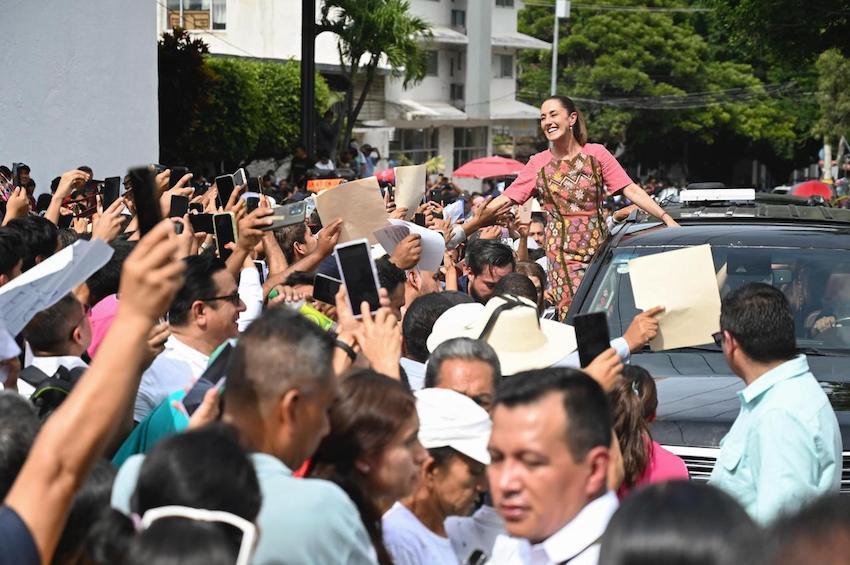President Claudia Sheinbaum is now officially in the second year of her six-year term: 366 days down, more than 1,800 still to go.
To mark the occasion of the first anniversary of her presidency, Mexico News Daily published Part 1 of “President Sheinbaum’s first year in office in 12 numbers” on Wednesday.
Here is Part 2.
32
This is the number of federal entities in Mexico, all of which Sheinbaum visited during her first year in office.
While the president lives in Mexico City, she travels to la provincia — a term used in Mexico to describe anywhere outside the capital — virtually every weekend.
In this respect, as in others, Sheinbaum is following in the footsteps of Andrés Manuel López Obrador, who traveled frequently and widely within Mexico during his presidency and once boasted of having visited each and every one of the country’s almost 2,500 municipalities. Also like AMLO, the presidenta is happy to get up close and personal with her supporters — she’ll kiss babies, high-five kids, hug grandmothers.
In September alone, Sheinbaum visited every state in the country on what she dubbed an “accountability tour,” delivering speeches to update residents on government projects and initiatives in their local areas.
“I made a decision, I decided to go to all the states of the republic to report because to govern is to be accountable,” she said during her “accountability” address in Aguascalientes on Sept. 5.
“You can’t govern far from the people, you have to govern close to the people and we have an idea about how to govern, and we say that we govern from the territory,” Sheinbaum said.

The president’s frequent trips to la provincia help her to consolidate her nationwide support, and undoubtedly provide good optics (just take a look at Sheinbaum’s social media). Saying your government is putting the poor first is one thing, visiting Mexico’s most disadvantaged communities and explaining to people firsthand what concrete actions are being taken to make their lives better is another.
It is worth noting that Sheinbaum finds herself in politically favorable territory in the majority of states across Mexico. The Morena party holds office in 23 of the 32 federal entities, while its ally, the Ecological Green Party of Mexico, governs one state (San Luis Potosí). The fact that more than 70% of Mexico’s states are governed by a party that only came into existence 11 years ago is nothing short of extraordinary. Can you imagine the same thing happening in a country like the United States or Canada?
The ubiquity of Morena’s political power across Mexico adds to the strength of Sheinbaum and her government, in part by ensuring that constitutional reforms approved by the federal Congress are ratified. Such reforms must be ratified by at least 17 of the state legislatures to take effect.
While she is in friendly territory in Morena entities, Sheinbaum has spoken about being well received in states governed by the National Action Party and the Institutional Revolutionary Party (PRI). That’s not surprising given that at least seven in ten Mexicans across the country approve of her performance as president, according to many polls.
What they’re saying
President Sheinbaum:
“We are always going to be close to the people, we will never abandon you.”
70
This is the number above which Sheinbaum’s approval rating remained throughout almost all of her first year in office.
There is no doubt that Sheinbaum is a wildly popular president.
Since she took office a year and a day ago, her approval rating has been above 70% every month except November, when it was 69%, according to the results of monthly polls conducted by the El Financiero newspaper. For four consecutive months between January and April, Sheinbaum’s approval rating exceeded 80% in El Financiero polls. Other surveys have yielded similar results.
So why is Sheinbaum so popular?
The one thing that stands out is her government’s provision of financial support for Mexican people — especially disadvantaged citizens — through its various welfare programs.
One recent poll identified “help for the people” as the president’s top achievement, while another found that 77% of respondents viewed the government’s social support programs in a positive light.
Although homicides have decreased during Sheinbaum’s term, a large majority of Mexicans do not approve of the federal government’s response to insecurity, poll results indicate.
However, it appears that a significant number of people are still prepared to support the president and her government despite its perceived shortcomings in combating insecurity and organized crime.
Beyond cash transfers — derided as vote-buying by some government critics — there are many other factors that can help explain Sheinbaum’s high level of popularity. They include the following:
- Sheinbaum is the successor and political protégé of Andrés Manuel López Obrador, a controversial but widely loved politician who built up a loyal following over a period of decades.
- She is Mexico’s first female president, a situation that automatically endears her to many women, and at least some men.
- Her support for double-digit increases to Mexico’s minimum wage.
- Her commitment to improving the lives of Mexico’s women.
- Her government’s management of the economy, which is growing (albeit at a modest rate) despite forecasts that it would contract in 2025.
- The current weakness of opposition parties.
- The perception that she is an honest and intelligent woman who is committed to serving the people of Mexico.
- A “rally ’round the flag’ effect amid frequent tariff threats from United States President Donald Trump and speculation that the U.S. could take military action against Mexican cartels on Mexican soil.
- Her tireless defense of Mexico’s sovereignty.
- Her appearance at press conferences every weekday morning, which allows her to set the national agenda and gives her a regular platform to communicate directly with the people of Mexico.
- Her extensive travel around Mexico, and willingness to get up and close with “the people.”
What they’re saying
Francisco Abundas, a renowned Mexican pollster:
“The [majority] approval of President Claudia Sheinbaum in August 2025 mainly depends on three factors: continuity and strengthening of the social programs, which maintain a connection with the majority [of Mexican people]; a favorable comparison with past governments, which reinforces the perception of relative efficiency; a personal image of close, honest and competent leadership, which legitimizes her decisions.”
Senator Alejando Moreno, national leader of the Institutional Revolutionary Party:
“[The federal government] has gone so far as to manipulate the population with social programs that don’t guarantee rights or solve structural problems, but do ensure political loyalty.”
3,145
This is the length in kilometers of the Mexico-United States border.
“Poor Mexico, so far from God, so close to the United States.”
The famous phrase is attributed to former Mexican president Porfirio Díaz, who ruled with an iron fist for more than three decades in the late 19th and early 20th centuries.
Mexico’s proximity to the world’s most powerful country and largest economy has its advantages, but — as the aforesaid phrase indicates — it comes with a healthy dose of challenges. That is certainly the case for the current occupant of Mexico’s National Palace.
For the past eight months, Sheinbaum has had to deal with an unpredictable, protectionist, hyperbolic and sometimes belligerent U.S. president whose administration has accused the Mexican government of being in cahoots with drug cartels.
Donald Trump has conveyed a simple message to Sheinbaum: Combat the cartels and stop narcotics and migrants from crossing Mexico’s northern border into the United States.
While the message is simple, achieving those objectives is exceedingly difficult — if not impossible.
Still, Trump expects results, and has shown he is willing to use the tools at his disposal — especially tariffs — to get (or at least attempt to get) what he wants. The threat of U.S. military action against cartels in Mexico (foreign terrorist organizations, according to the U.S.) looms as a possibility, as unrealistic as that eventuality appears to some, including the presidenta herself.
Sheinbaum has made some progress toward achieving the objectives Trump has set for her. Data indicates that the quantity of drugs and migrants entering the U.S. via its 3,145-kilometer-long border with Mexico has declined significantly. Under pressure from the U.S., the Sheinbaum administration has deployed additional troops to the northern border region, sent dozens of cartel figures to face justice in the U.S., seized large quantities of narcotics and destroyed more than 1,400 drug labs.
Nevertheless, satisfying Trump on the drug issue is no easy feat, perhaps impossible, given that Americans continue to die from drug overdoses and blaming Mexico for the problem (and China, Venezuela and other countries) is seen as a surefire way to make political capital.
Sheinbaum has earned praise for the way in which she has handled Trump, won some concessions from him and the pair say they have a good relationship. But the fact remains that there are U.S. tariffs on a range of Mexican goods, including steel, aluminum and vehicles, that didn’t exist before the current U.S. president returned to the White House.
Still, given that Trump has also imposed new tariffs on goods from U.S. allies around the world, it is unfair to apportion blame to Sheinbaum for the protectionist status quo in intra-North American trade.
In addition to slapping tariffs on Mexico, the United States’ largest trade partner, Trump has repeatedly made the unedifying claim that Sheinbaum is “afraid” of the cartels, even as his secretary of state and ambassador in Mexico have commended her government for its security work.
There is criticism at home as well: A recent poll found that a majority of Mexicans believe that the Sheinbaum administration is not doing a good job managing the relationship with the U.S. president.
Attending to the Mexico-United States relationship will be an ongoing and ever-evolving task for Sheinbaum during the next five years of her presidency. Next year will be especially pivotal given that the USMCA is up for review.
While trade and security have been the key focus of the bilateral relationship over the past 12 months, it is important not to forget that there are a range of other binational challenges, including ones related to Mexico’s water debt, the ongoing screwworm saga and the Tijuana-San Diego sewage crisis.
What they’re saying
President Sheinbaum:
“We collaborate, we coordinate, we work together [with the United States], but we will never be subordinated. Mexico is a free, sovereign, independent country and we don’t accept interventionism in our country.”
Marco Rubio, United States Secretary of State:
“We’ve had a great relationship with the government of Mexico during the eight months of the Trump presidency. It is the closest security cooperation we have ever had, maybe with any country, but certainly in the history of U.S.-Mexico relations.”
Carlos Pérez Ricart, an academic who focuses on arms trafficking, drug policy and organized crime:
“This bilateral relationship can’t be described as cooperation, but rather as extortion.”
“The Mexican government is prepared to concede almost anything in order to safeguard the renegotiation of the USMCA and preserve the promise of low tariffs.”
32,400+
This is the number of people arrested for allegedly committing “high-impact” crimes during Sheinbaum’s first year in office.
On Sept. 9, Federal Security Minister Omar García Harfuch reported that more than 32,400 people had been arrested since Oct. 1, 2024.
The figure is striking for at least two reasons.
It indicates that an average of around 95 people were arrested for crimes such as homicide, kidnapping, rape and extortion each and every day over the past year. Considering that impunity is still considered to be a major problem in Mexico, the average daily number of arrests and the accumulated figure are extraordinarily high, demonstrating that the federal government’s security strategy — which includes enhanced intelligence and investigation practices — is working.
![Speaking of her administration's security strategy, Sheinbaum emphasized "prevention, intelligence and presence [of security forces]."](https://mexiconewsdaily.com/wp-content/uploads/2024/10/WhatsApp_Image_2024-10-08_at_9.57.09_AM.jpeg)
The high number of arrests over the past year also creates a significant additional challenge for Mexico’s recently renewed judiciary, which will have to assess the culpability of a huge number of suspects. The pace of justice delivery in Mexico is already glacial, in many cases. The additional burden could make things even worse.
With so many people being arrested, another issue to consider is overcrowding in Mexico’s notoriously overcrowded jails. Sheinbaum has acknowledged that her government is considering building new penitentiaries.
What they’re saying
Security Minister Omar García Harfuch:
“The joint work of the Ministry of National Defense, the Ministry of the Navy, the Ministry of Security and Citizen Protection, the Federal Attorney General’s Office, the Ministry of the Interior, the National Guard and the National Intelligence Center has made it possible to dismantle criminal networks, detain priority targets, execute judicial orders, and also impact the financial structures of criminal groups through the [drug] seizures carried out.”
U.S. President Donald Trump:
“Mexico still has not stopped the Cartels who are trying to turn all of North America into a Narco-Trafficking Playground.”
130,000+
This is the number of people officially classified as missing in Mexico.
Sheinbaum, like leaders around the world, inherited a range of problems when she took office.
Mexico’s long-running missing persons crisis is one of the biggest. The president is determined to make progress on addressing the problem, but disappearances have remained a major problem during her administration.
In March, as the discovery of a so-called extermination camp in the state of Jalisco continued to provoke horror in Mexico, Sheinbaum declared that “attending to the problem of missing persons” was a “national priority” for her government.
The president subsequently announced six actions against abductions, including the strengthening of the National Search Commission and legislative reform.

But some of the most important stakeholders in the plan — the families of the missing — are not convinced it is the right way forward (see below).
Within the vast missing persons crisis, Sheinbaum inherited the unresolved, 11-year-old Ayotzinapa case — the disappearance of 43 teachers’ college students in Guerrero in September 2024.
Effectively dealing with Mexico’s missing persons crisis — including solving unresolved cases, holding abductors to account and reducing the incidence of new cases — will be a major challenge for the president. If she can effectively address the problem, and convince the people of Mexico that she has done so, millions of Mexicans will thank her, not least the nation’s madres buscadoras (searching mothers) and other relatives of the missing.
The failure to do so would taint the Sheinbaum administration, especially considering that the president has made addressing the missing persons problem a “national priority.”
What they’re saying
An open letter to Sheinbaum endorsed by search collectives, activists and relatives of victims of abduction and enforced disappearance:
“The families of disappeared persons saw and listened to your response in the face of a disappearances crisis that gets worse every day. The proposal you make deeply concerns us as it reflects a lack of awareness of the institutional search and investigation mechanisms and procedures that already exist in the country.”
34.3 billion
This is the amount in US dollars that Mexico received in foreign direct investment (FDI) in the first six months of 2025.
Despite concerns about the judicial reform — and President Trump’s subversion of the USMCA with the implementation of tariffs on a range of Mexican goods — FDI in Mexico hit a record high in the January-June period of this year.
This is undoubtedly a win for Sheinbaum and her administration, which is aiming to attract foreign investment, boost domestic manufacturing capacity and reduce reliance on imports.
All three of those objectives are part of the government’s ambitious Plan México economic plan, which was unveiled in January.
In a social media post after the publication of the FDI data for the first six months of the year, Sheinbaum asserted that the “Fourth Transformation [economic] model doesn’t just reduce poverty, it generates investment as well.”
An especially positive aspect of the aforementioned data is that the “new investment” component more than tripled between January and June compared to the first six months of 2024.
The federal government will be hoping that trend continues, and that new projects are launched across the country, not just in areas that have traditionally attracted high levels of FDI such as northern Mexico and the Bajío region.
A slogan of the Sheinbaum administration is “shared prosperity” — it wants Mexico’s wealth (including that derived from foreign investment) to be shared among all Mexicans, no matter their background or where in the country they live.
Continuing to receive record levels of FDI, and attracting at least some of that investment to historically disadvantaged parts of Mexico, could go a long way to helping the government achieve its “shared prosperity” goal. Conversely, any significant slump in FDI would undermine that initiative, and affect Mexico’s overall economic wellbeing as well.
With Plan México and other initiatives, including security and infrastructure-focused ones, Sheinbaum and her government will be determined to do everything they can within their control to make sure that doesn’t happen in the coming years.
What they’re saying
Mexico’s federal Economy Ministry:
“Mexico attracted new investments amounting to US $ 3.149 billion [in the first six months of 2025], which is 246% more than in 2024. … This is the highest growth in the last 12 years. It reaffirms the interest that foreign investors maintain in our country, despite the global economic and political scenario.”
By Mexico News Daily chief staff writer Peter Davies (peter.davies@mexiconewsdaily.com)
Looking for Part 1?
President Sheinbaum’s first year in office in 12 numbers: Part 1
